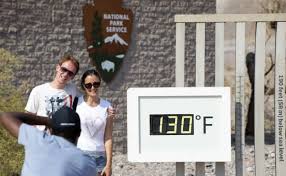Typically, such blazing heat records fall during July, which is the Northern Hemisphere’s hottest month
Source: The Washington Post
In the midst of a historic heat wave in the West, the mercury in Death Valley, Calif., surged to a searing 130 degrees on Sunday afternoon, possibly setting a world record for the highest temperature ever observed during the month of August.
If the temperature is valid, it would also rank among the top-three highest temperatures ever measured on the planet at any time and may, in fact, be the highest.
The temperature in Death Valley hit 130 degrees at 3:41 p.m. Pacific time on Sunday, according to the National Weather Service. If verified, the reading would break Death Valley’s previous August record by three degrees, the Weather Service tweeted.
“Everything I’ve seen so far indicates that is a legitimate observation,” Randy Cerveny, who leads the World Meteorological Organization’s weather and climate extremes team, wrote in an email. “I am recommending that the World Meteorological Organization preliminarily accept the observation. In the upcoming weeks, we will, of course, be examining it in detail, along with the U.S. National Climate Extremes Committee, using one of our international evaluation teams.”
Death Valley famously holds the record for the hottest temperature ever recorded on Earth, which is 134 degrees. This record was set on July 10, 1913. However, that measurement is very much in question; an extensive analysis of that record conducted in 2016 by Christopher Burt, an expert on extreme weather data, concluded it was “essentially not possible from a meteorological perspective.”
Some climatologists consider 129-degree readings recorded in Death Valley on June 30, 2013, and in Kuwait and Pakistan in 2016 and 2017, respectively, as the highest ever reliably measured on the planet. If only those readings are considered, then Sunday’s 130-degree temperature would unseat them as the highest measured.
As it stands, if Sunday’s 130-degree reading is confirmed, it would be the world’s highest temperature officially recorded since 1931, and the third-highest since 1873. The only two higher measurements include the disputed 1913 Death Valley reading and a 131-degree reading from Kebili, Tunisia, set July 7, 1931, which is considered to be Africa’s hottest temperature. But the Tunisia mark also has “serious credibility issues,” according to Burt.
Death Valley is the lowest, driest and hottest location in the United States. Furnace Creek, where its temperature is measured, sits at 190 feet below sea level in the Mojave Desert of southeastern California. It is notorious for its blistering heat. In July 2018, its average temperature of 108.1 degrees represented the hottest month ever measured on the planet. During that month, it hit at least 120 degrees on 21 days.
Typically, such blazing heat records happen in July — the Northern Hemisphere’s hottest month — which makes Sunday’s 130-degree reading stand out.
The scorching temperature occurred amid a suffocating heat wave that has gripped the Western United States since late last week, and is forecast to continue into the coming week.
On Friday, Oakland, Calif., hit 100 for the first time on record in August, while Phoenix tied its highest temperature for the month: 117 degrees.
Then on Saturday, Needles, in California’s southeastern desert, soared to 123 degrees, its highest August temperature on record.
Sacramento rocketed to 112 degrees Sunday, topping its previous August record of 110.
Scientists have found the intensity, duration and frequency of heat waves worldwide are increasing due to human-caused climate change. A 2019 study found the planet has entered a “new climate regime” with “extraordinary” heat waves that global warming is worsening.
Climate studies have also concluded climate change is having a serious effect on wildfire activity in the West and Southwest. The Fourth National Climate Assessment, published by the Trump administration in 2018, warned that climate change had already increased the size of areas burned by wildfires by drying out forests and boosting the availability of wildfire fuel.
The report estimated the area burned by wildfires in the past decade was twice what it otherwise would have been without climate change, painting a grim picture of the region’s future.
Source: The Washington Post

































Leave a Comment
You must be logged in to post a comment.